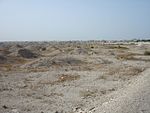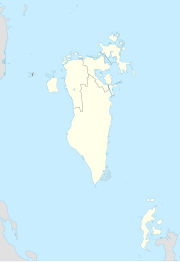List of World Heritage Sites in Bahrain
The United Nations Educational, Scientific and Cultural Organization (UNESCO) designates World Heritage Sites of outstanding universal value to cultural or natural heritage which have been nominated by signatories to the 1972 UNESCO World Heritage Convention.[1] Cultural heritage consists of monuments (such as architectural works, monumental sculptures, or inscriptions), groups of buildings, and sites (including archaeological sites). Natural features (consisting of physical and biological formations), geological and physiographical formations (including habitats of threatened species of animals and plants), and natural sites which are important from the point of view of science, conservation or natural beauty, are defined as natural heritage.[2] Bahrain accepted the convention on May 28, 1991, making its historical sites eligible for inclusion on the list. It has three World Heritage Sites and a further six sites on the tentative list.[3] The first site listed was the Qal’at al-Bahrain – Ancient Harbour and Capital of Dilmun, in 2005, while the most recent one was the Dilmun Burial Mounds, in 2019. All three sites are listed for their cultural significance. Bahrain has served on the World Heritage Committee twice.[3]
World Heritage Sites[edit]
UNESCO lists sites under ten criteria; each entry must meet at least one of the criteria. Criteria i through vi are cultural, and vii through x are natural.[4]
| Site | Image | Location (governorate) | Year listed | UNESCO data | Description |
|---|---|---|---|---|---|
| Qal'at al-Bahrain – Ancient Harbour and Capital of Dilmun | 
|
Capital | 2005 | 1192ter; ii, iii, iv (cultural) | The site of Qal’at al-Bahrain has been occupied since at least 2300 BCE, with successive settlements forming an artificial mound, a tell. The oldest strata are attributed to the Dilmun civilization, known from the Sumerian sources. Located at the strategic location in the Persian Gulf, they traded with the Indus Valley and Mesopotamia. It continued to be an important trade port during the Tylos and Islamic periods. Fortifications from different periods have been preserved, the most prominent being the Portuguese fort from the 16th century (pictured). Excavations have uncovered remains of residential, commercial, military, and religious buildings. Minor modifications of the site boundaries took place in 2008 and 2014.[5] |
| Pearling, Testimony of an Island Economy | 
|
Muharraq | 2012 | 1364rev; iii (cultural) | Pearl harvesting was an important economy in the Persian Gulf from the 2nd to the 20th century, with its peak in the late 19th and early 20th centuries. Pearls were collected from oyster beds offshore. The pearling industry rapidly declined in the 1930s with the development of freshwater pearl cultivation from mussels in Japan. The site comprises three oyster beds, 17 buildings in Muharraq city that were related to the industry (Isa Bin Ali House pictured), parts of the seashore, and the Bu Maher Fort.[6] |
| Dilmun Burial Mounds | 
|
Capital, Northern, Southern | 2019 | 1542; iii, iv (cultural) | The Dilmun Burial Mounds, built between 2200 and 1750 BCE, span over 21 archaeological sites in the western part of the island. Six of these sites are burial mound fields consisting of a few dozen to several thousand tumuli. In all there are about 11,774 burial mounds, originally in the form of cylindrical low towers. The other 15 sites include 17 royal mounds, constructed as two-storey sepulchral towers. The burial mounds are evidence of the Early Dilmun civilization, around the 2nd millennium BCE, during which Bahrain became a trade hub whose prosperity enabled the inhabitants to develop an elaborate burial tradition applicable to the entire population. These tombs illustrate globally unique characteristics, not only in terms of their number, density and scale, but also in terms of details such as burial chambers equipped with alcoves.[7] |
Tentative list[edit]
In addition to sites inscribed on the World Heritage List, member states can maintain a list of tentative sites that they may consider for nomination. Nominations for the World Heritage List are only accepted if the site was previously listed on the tentative list.[8] Bahrain lists six properties on its tentative list.[3]
| Site | Image | Location (governorate) | Year listed | UNESCO criteria | Description | |
|---|---|---|---|---|---|---|
| Khor Hamad Town Tumuli Moundfield | 
|
Northern Governorate | Cultural | 2001 | [9] | |
| Barbar Temple | 
|
Northern Governorate | Cultural | 2001 | [10] | |
| Saar Heritage Park | 
|
Northern Governorate | Cultural | 2001 | [11] | |
| Hawar Islands Reserve | 
|
Southern Governorate | Natural (vii) (ix) | 2001 | [12] | |
| Manama, City of Trade, Multiculturalism and Religious Coexistence | 
|
Capital Governorate | Cultural (ii) (iii) | 2018 | [13] | |
| Awali oil settlement | 
|
Southern Governorate | Cultural (ii) (iv) | 2019 | [14] |
References[edit]
- ^ "The World Heritage Convention". UNESCO World Heritage Centre. Archived from the original on 27 August 2016. Retrieved 21 September 2010.
- ^ "Convention Concerning the Protection of the World Cultural and Natural Heritage". UNESCO World Heritage Centre. Archived from the original on 1 February 2021. Retrieved 3 February 2021.
- ^ a b c "Bahrain". UNESCO. Retrieved January 8, 2024.
- ^ "UNESCO World Heritage Centre – The Criteria for Selection". UNESCO World Heritage Centre. Archived from the original on 12 June 2016. Retrieved 17 August 2018.
- ^ "Qal'at al-Bahrain – Ancient Harbour and Capital of Dilmun". UNESCO World Heritage Centre. Retrieved 3 May 2024..
- ^ "Pearling, Testimony of an Island Economy". UNESCO World Heritage Centre. Retrieved 3 May 2024.
- ^ "Dilmun Burial Mounds". UNESCO World Heritage Centre. Retrieved 3 May 2024.
- ^ "Tentative Lists". UNESCO World Heritage Centre. Archived from the original on 1 April 2016. Retrieved 7 October 2010.
- ^ "Hamad Town Tumuli Moundfield". UNESCO World Heritage Centre. Retrieved 2024-01-08.
- ^ "Barbar Temple". UNESCO World Heritage Centre. Retrieved 2024-01-08.
- ^ "Saar Heritage Park". UNESCO World Heritage Centre. Retrieved 2024-01-08.
- ^ "Hawar Islands Reserve". UNESCO World Heritage Centre. Retrieved 2024-01-08.
- ^ "Manama, City of Trade, Multiculturalism and Religious Coexistence". UNESCO World Heritage Centre. Retrieved 2024-01-08.
- ^ "Awali oil settlement". UNESCO World Heritage Centre. Retrieved 2024-01-08.


